
Alstroemeria, commonly called the Peruvian lily or lily of the Incas, is a genus of flowering plants in the family Alstroemeriaceae. They are all native to South America, although some have become naturalized in the United States, Mexico, Australia, New Zealand, Madeira and the Canary Islands. Almost all of the species are restricted to one of two distinct centers of diversity: one in central Chile, the other in eastern Brazil. Species of Alstroemeria from Chile are winter-growing plants, while those of Brazil are summer growing. All are long-lived perennials except A. graminea, a diminutive annual from the Atacama Desert of Chile.

Agave americana, commonly known as the century plant, maguey, or American aloe, is a flowering plant species belonging to the family Asparagaceae. It is native to Mexico and the United States, specifically Texas. This plant is widely cultivated worldwide for its ornamental value and has become naturalized in various regions, including Southern California, the West Indies, South America, the Mediterranean Basin, Africa, the Canary Islands, India, China, Thailand, and Australia.

Syringa vulgaris, the lilac or common lilac, is a species of flowering plant in the olive family, Oleaceae. Native to the Balkan Peninsula, it is widely cultivated for its scented flowers in Europe and North America.

Abutilon pictum, syn. Abutilon striatum (disputed), is a species of flowering plant in the family Malvaceae. It is native to southern Brazil, Argentina, Paraguay and Uruguay. The plant has become naturalised in Central America, and is used in horticulture. Common names include redvein abutilon, red vein Indian mallow, redvein flowering maple, Chinese-lantern and red vein Chinese lanterns.
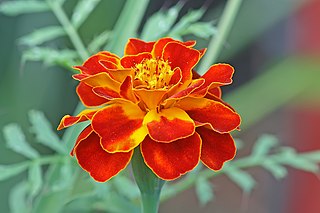
Tagetes patula, the French marigold, is a species of flowering plant in the family Asteraceae, native to Mexico and Guatemala with several naturalised populations in many other countries. It is widely cultivated as an easily grown bedding plant with hundreds of cultivars, which often have bright yellow to orange flowers.
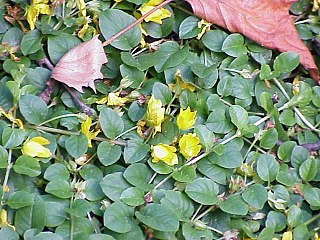
Lysimachia nummularia is a species of flowering plant in the primrose family Primulaceae. Its common names include moneywort, creeping jenny, herb twopence and twopenny grass.

Jasminum nudiflorum, the winter jasmine, is a slender, deciduous shrub native to China. The flower's blossoming peaks right after winter, which is why it is also named Yingchun (迎春) in Chinese, which means "the flower that welcomes Spring". It is widely cultivated as an ornamental and is reportedly naturalized in France and in scattered locations in the United States.
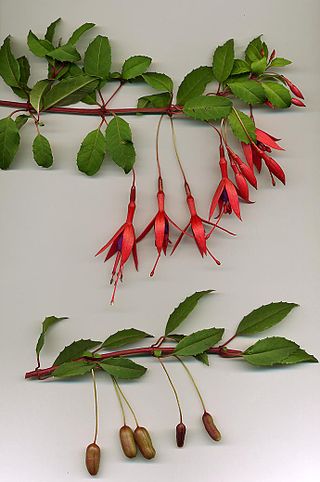
Fuchsia magellanica – commonly known as the hummingbird fuchsia, hardy fuchsia or chilco – is a species of flowering plant in the evening primrose family Onagraceae, native to the lower Southern Cone of southern South America.

Cornus alba, the red-barked, white or Siberian dogwood, is a species of flowering plant in the family Cornaceae, native to Siberia, northern China and Korea. It is a large deciduous surculose (suckering) shrub that can be grown as a small tree. As a popular ornamental used in landscaping its notable features include the red stems in fall (autumn) through late winter, bright winter bark; and the variegated foliage in some cultivars, such as C. alba 'Elegantissima'. C. alba can grow to 3 m (10 ft) high, but variegated forms are less vigorous. For the brightest winter bark, young shoots are encouraged by cutting to the ground some older stems at the end of the winter, before leaves are open. The oval fruits are white, sometimes tinted blue.

Rudbeckia triloba, the browneyed or brown-eyed susan, thin-leaved coneflower or three-leaved coneflower, is a species of flowering plant in the family Asteraceae with numerous, yellow, daisy-like flowers. It is native to the central and eastern United States and is often seen in old fields or along roads. It is also cultivated as an ornamental.

Brugmansia aurea, the golden angel's trumpet, is a species of flowering plant in the nightshade family Solanaceae, endemic to Ecuador. Since March 2014, it has been listed as Extinct in the Wild by the IUCN but before that, it was listed as Vulnerable.

Malus transitoria, the cut-leaf crabapple, is a species of flowering plant in the crabapple genus Malus of the family Rosaceae, native to China.
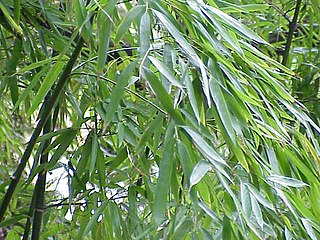
Phyllostachys aurea is a species of bamboo, and is of the 'running bamboo' type, belonging to the diverse Bambuseae tribe. It is native to Fujian and Zhejiang in China. It is commonly known by the names fishpole bamboo, golden bamboo, monk's belly bamboo, and fairyland bamboo (Australia).

Chrysojasminum humile, the Italian jasmine or yellow jasmine, is a species of flowering plant in the family Oleaceae, native to Afghanistan, Tajikistan, Pakistan, Nepal, Burma (Myanmar), the Himalayas and south west China. The species is widely cultivated and reportedly naturalized in Greece, Sicily and the former Yugoslavia.
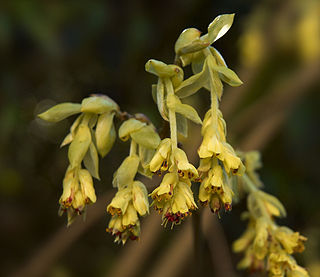
Corylopsis pauciflora, the buttercup witch hazel or winter hazel, is a species of flowering plant in the family Hamamelidaceae, native to Taiwan and Japan. It is a deciduous, spreading shrub growing to 1.5 m tall by 2.5 m wide. It produces masses of pale yellow flowers in pendent racemes in early spring, followed by leaves opening bronze and turning to rich green. It is cultivated in gardens and parks in temperate regions.
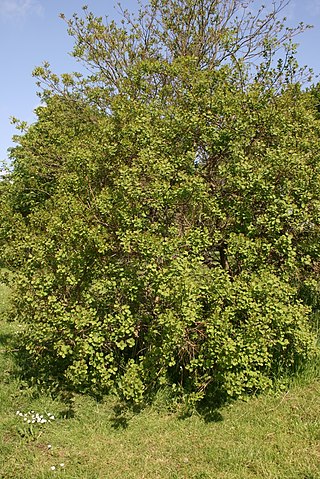
Cotinus obovatus syn. C. americanus, the American smoketree, chittamwood or American smokewood, is a rare species of flowering plant in the genus Cotinus of the family Anacardiaceae, native to scattered locations in Oklahoma, Texas, Arkansas, Missouri, Alabama and Tennessee. It is a deciduous, conical shrub growing to 10 m (33 ft) tall by 8 m (26 ft) broad, with oval leaves up to 12 cm (5 in) long. It produces panicles of pink-grey flowers in summer, and its foliage turns a brilliant scarlet in autumn; considered by many to be the most intense fall color of any tree. The smokey effect derives from the clusters of hairs on the spent flower stalks. It is highly sought after and cultivated in botanical gardens worldwide. It is dioecious, with male and female flowers on separate plants.

Eucomis pallidiflora, the giant pineapple lily, is a bulbous species of flowering plant in the family Asparagaceae, subfamily Scilloideae, native to southern Africa. The white to green flowers appear in summer and are arranged in a spike (raceme), topped by a "head" of green leaflike bracts. Some forms reach almost 2 m when in flower. The species is cultivated as an ornamental plant, although it is not hardy in areas where severe frosts occur.
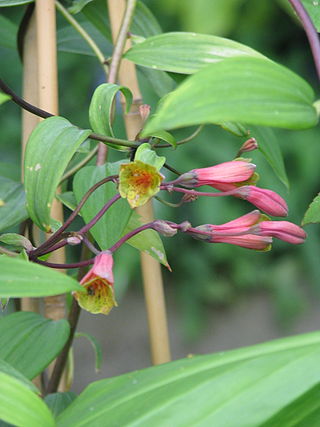
Bomarea edulis, common name salsilla, is a species of flowering plant in the alstroemeria family Alstroemeriaceae, that is native to the tropics of Mexico and the United States. A deciduous climber growing to 2.5 metres (8.2 ft) tall and wide, it has lanceolate leaves and clusters of trumpet-shaped flowers in shades of pink, yellow and green, with variable spotting, that are produced throughout the summer.

Hypericum kouytchense, the large-flowered St John's wort, is a species of flowering plant in the family Hypericaceae, native to Western China. Growing up to 3 ft (0.91 m) tall and 5 ft (1.5 m) wide, it is a semi-evergreen rounded shrub with blue-green leaves and large yellow flowers with prominent stamens, appearing in midsummer. Flowers are followed by red seed capsules in autumn. Where conditions are favourable it can retain its leaves all year.

Stachyurus praecox, early stachyurus, is a species of flowering plant in the family Stachyuraceae, native to Japan. It is a spreading deciduous shrub growing to 4 m (13 ft) tall by 3 m (10 ft) wide. Pendent, bell-shaped, primrose yellow flowers are borne on naked arching branches in winter and spring. They are followed by ovate leaves, which colour to pink or red before falling in autumn.
























